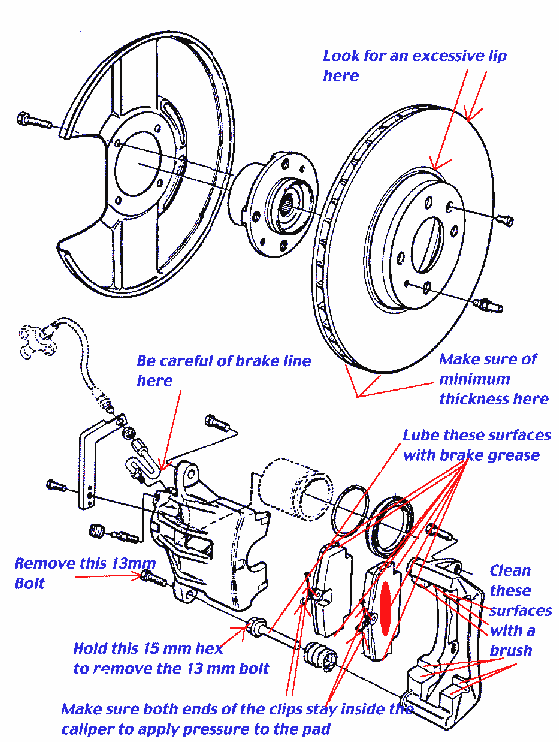
Front Brake
Pad Replacement 88-> 900, 86-88 9000 without
ABS
First pop the hood and have a look at the fluid level in the brake reservoir. If its anywhere near full, remove a bit of the fluid as you will be retracting the pistons in the calipers and raising this level. It can overflow and brake fluid will eat painted surfaces bare.
Loosen the lug nuts on both front wheels, not take them off, just break them loose with the car on the ground. set the emergency brake to hold the car.
Then do one side at a time. Jack up one side, being certain the jack is secure. You will need a thin 15 mm wrench and a 13 mm socket. Remove the lower 13 mm bolt while holding the 15 mm hex behind it on the caliper slide. Use a large screwdriver between the rotor and the caliper to start compressing the piston back enough so the pads loosen from the rotor or until you get enough clearance to swint the caliper upwards enabling you to remove the old pads. Clean everything with brake cleaner ( a spray product for less than $5 a can) to get rid of the old brake dust. Use a big pair of pliers or a c clamp to fully compress the piston. It should just push back into the caliper. You can slide the upper slide out of the bracket and remove the caliper to get at it easier.

Inspect the rotors at this point. They should be marked with a minimum thickness spec of 21.5 mm. If I can slip a 22 mm ( 7/8") open ended wrench over them, they get replaced. If they are below this thickness, they are unsafe and should be replaced. If they have deep grooves, they should be replaced. If you had vibration in the steering wheel when braking from highway speeds, they should be replaced. If the edge of the rotor has a ridge on it where the pads have worn the rotor over 1 mm, you might have a noise problem and the ridge will contact the back of the pads before the pads are worn out and right at that time, braking efficiency may become dangerous. Replace the rotors if this is the case. Otherwise, we just install new pads. We NEVER turn/resurface Saab rotors. replace the rotors as a pair if you need to replace one to insure even braking and pad life.
Look at the rubber bits on the caliper. If they are in bad shape replace them.
While the caliper is out, use a high temperature synthetic grease to lube the slide pin. Pull out the lower slide pin which should still be in the bracket the caliper mounts to and lube it as well. Push the lower pin back into the bracket.
Apply the same lubricant to the backs of the new pads and their backing's edges where they will contact the caliper. Install the outer pad in the bracket for the caliper and the inner pad with its clips into the caliper's piston. Slide the upper pin still attached to the caliper back in its hole at the top of the caliper mount.
Swing the caliper back down into position and reinstall the lower bolt using a bit of LocTite to be safe on the bolt. With new pads, the brake line may interfer with the upper bolt holding the caliper mounting bracket on the knuckle, keeping the caliper from going back down. If it does, very carefully bend it back out of the way just enough to get the caliper down. Be real careful not to crimp that line. If you are afraid of bending the line, just remove the upper 13 mm bolt as you did the lower one, install the slide pin in the mount and reinstall the caliper. As you reinstall the caliper, make sure the rattle clips on the top of the pads get compressed by the caliper. They can turn so only one end of them does and the other will stick out through the hole in the caliper. Eventually, as the pads wear, the one sticking out will grab on the caliper and you'll have a problem.
The combination of the lube on the back of the pads and the clips help eliminate pad rattling and squealing.
Replace the wheel and torque the lug nuts evenly to 80 ft/lbs to prevent warping the rotors.
Do the other side.
If you have not flushed the brake fluid in the last 2 years/30000 miles, now would be an excellent time to do so.
Now, before you drive off, get in the car and pump the brake pedal until the feel is firm and the pedal effort gets hard at the top of the travel. This "adjusts' the pistons to the new pads.
Go on a test drive and for the first few miles avoid sudden high speed stops to seat the pads. New pads can be glazed easily and the result will be a squeal and rotor wear/warpage. If all four wheels get pads at once, you may feel like the pedal is mushy. This can be caused by all new pads and the compression the now thick new friction material allows. Make sure the car will stop and if after a few days the feeling doesn't go back to feeling normal, re bleed the brakes just to be sure.